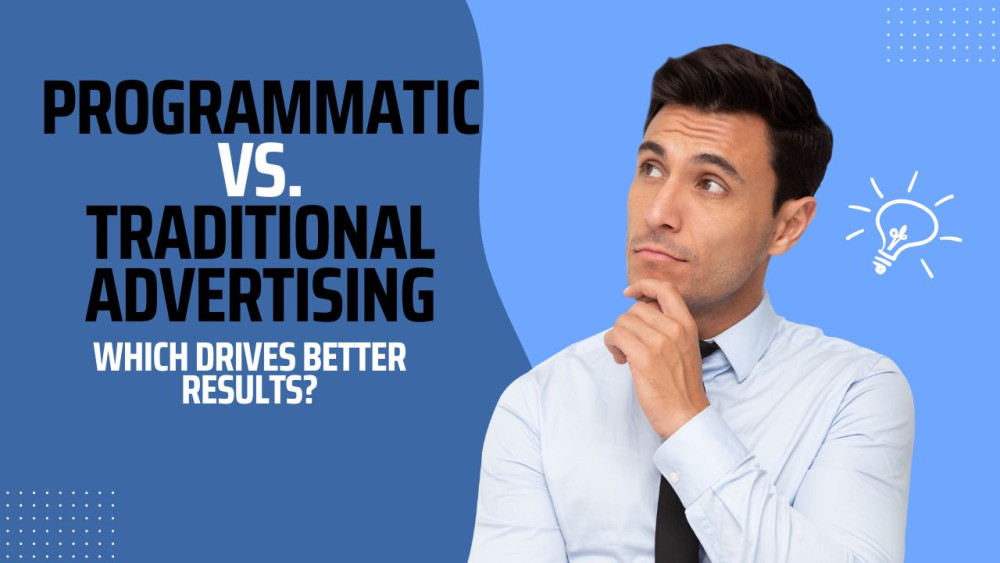In the golden age of advertising, brands relied on billboards, television spots, and magazine spreads to capture the attention of potential customers. It was a simpler time—advertisers had fewer channels to worry about, and marketing success was often measured in broad strokes. But as the digital revolution gained momentum, a new player emerged in the advertising world: programmatic advertising.
Today, advertisers are faced with a crucial decision—stick to the tried-and-tested methods of traditional advertising, or embrace the data-driven efficiency of programmatic advertising? Which one delivers better results? Let’s dive in.
The Old Guard: Traditional Advertising
Traditional advertising has been the cornerstone of marketing for decades. It includes television, radio, print, billboards, and direct mail. These methods have proven effective in creating brand awareness and reaching a large audience.
Strengths of Traditional Advertising:
High Visibility & Brand Credibility – TV commercials during prime time, magazine ads in popular publications, and billboards in high-traffic areas can make a brand look established and trustworthy.
Mass Audience Reach – Traditional ads reach broad demographics, making them ideal for brands that want widespread exposure.
Emotional Impact – A well-executed TV commercial can evoke emotions and create a lasting impression in ways that digital ads sometimes struggle to achieve.
Less Ad Fatigue – Since people are less bombarded by traditional ads compared to online ones, they may be more receptive to the message.
However, traditional advertising comes with challenges. High costs, difficulty in measuring precise ROI, and lack of real-time optimization make it less appealing in today’s fast-moving digital world.
The New Era: Programmatic Advertising
Imagine an ad that knows exactly who you are, what you like, and when you’re most likely to make a purchase. That’s the power of programmatic advertising.
Programmatic advertising uses AI and automation to buy digital ad space in real-time, ensuring the right ad is delivered to the right person at the right time. Unlike traditional advertising, programmatic platforms rely on data to target specific audiences rather than broadcasting messages to the masses.
Strengths of Programmatic Advertising:
Precision Targeting – With programmatic, you can target users based on their demographics, online behavior, interests, and even past purchases.
Real-Time Bidding (RTB) – Advertisers bid on ad impressions in milliseconds, ensuring cost efficiency and better budget utilization.
Scalability & Flexibility – Whether you want to run a small campaign or reach millions worldwide, programmatic allows you to scale seamlessly.
Measurable Performance – Unlike traditional ads, programmatic campaigns provide real-time data and analytics, allowing marketers to tweak and optimize in real time.
Cross-Device Targeting – Programmatic ads can follow users across smartphones, tablets, laptops, and smart TVs, providing a seamless experience.
Despite its advantages, programmatic isn’t perfect. Ad fraud, brand safety concerns, and over-reliance on algorithms can pose risks if not managed properly.
The Showdown: Which One Delivers Better Results?
Now comes the big question—which is more effective? The answer depends on your business goals.
If you’re a luxury brand looking for prestige and high-end visibility, a Vogue magazine spread or a Super Bowl commercial might be your best bet.
If you’re an e-commerce brand aiming for conversions, programmatic advertising can drive measurable sales through retargeting and personalized messaging.
If you want to build long-term brand awareness, traditional advertising can offer credibility, while programmatic can ensure precise audience engagement.
Finding the Perfect Balance
Rather than choosing one over the other, the best strategy is often a hybrid approach. Many brands now integrate both traditional and programmatic advertising to maximize impact. For example:
A car brand launches a TV commercial for mass appeal while running programmatic display ads to retarget users who searched for their vehicles online.
A fashion brand places an ad in a high-end magazine to build prestige while using programmatic social ads to drive online conversions.
A travel agency invests in billboards at airports while running programmatic geo-targeted ads for people searching for vacations.
Final Verdict
While traditional advertising still holds weight in branding, programmatic advertising has the upper hand when it comes to efficiency, data-driven results, and ROI. The modern marketing landscape requires agility, and programmatic provides the tools to adjust campaigns in real time, ensuring every ad dollar is spent wisely.
For brands looking to maximize their advertising impact, the smartest choice isn’t traditional vs. programmatic—it’s knowing when and how to use both effectively. In an ever-evolving digital world, adaptability is the key to success.


